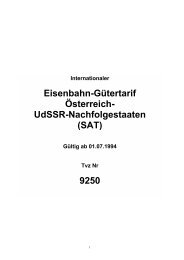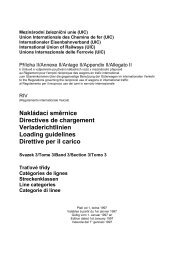Gustáv Slamečka - ČD Cargo, as
Gustáv Slamečka - ČD Cargo, as
Gustáv Slamečka - ČD Cargo, as
- TAGS
- cargo
- www.cdcargo.cz
Create successful ePaper yourself
Turn your PDF publications into a flip-book with our unique Google optimized e-Paper software.
HISTORIE DOPRAVY / TRANSPORT HISTORY<br />
Poslední vítězná plavba<br />
plachetníku Moshulu /<br />
The L<strong>as</strong>t Winning Journey<br />
of the Sailboat Moshulu<br />
Ještě vl<strong>as</strong>tně nedávno se konaly každoroční dostihy<br />
nákladních plachetnic s pšenicí z Austrálie do Evropy.<br />
Until very recently, sailboats loaded with wheat vied<br />
for primacy each year on the Australia-Europe route.<br />
TEXT / TEXT BY JIŘÍ ŠKUBA FOTO / PHOTO BY ARCHIV, PROFIMEDIA / ARCHIVE, PROFIMEDIA<br />
62 REVUE PRO DOPRAVU A LOGISTIKU<br />
Pro pestrý stůl nebo jen proti hladu Evropa<br />
vždy doplňovala spotřebu potravin<br />
dovozem. O pšenici to platilo už ve starověku,<br />
Kleopatra nebyla pro Cesara zřejmě přitažlivá<br />
jen pro svou krásu (která podle portrétu<br />
na dochované minci nebyla až z<strong>as</strong> tak<br />
oslňující), ale její půvab podstatně zvyšovala<br />
pšenice z egyptské obilnice Říma.<br />
Angličan Eric Newby, který jednoho<br />
krásného dne v říjnu 1838 podlehl romantickému<br />
volání a nechal se najmout jako<br />
plavčík na jednu z posledních plachetnic<br />
v této službě, v knize, kterou napsal již jako<br />
známý novinář a cestovatel, podal v podstatě<br />
dokumentární svědectví o poslední<br />
slávě velkých obilních plachetníků, kdysi<br />
královen moří.<br />
Doprava obilí živila poslední<br />
plachetníky<br />
I když se absolutní vítězství páry v námořní<br />
dopravě odehrálo již ve druhé polovině<br />
devatenáctého století, existovalo před<br />
2. světovou válkou, v roce 1938, ještě třináct<br />
lodí poháněných výhradně plachtami,<br />
které vozily kolem mysu Horn do Evropy<br />
obilí z Austrálie. Velké plachetníky se udržely<br />
v tomto obchodu díky příznivým vl<strong>as</strong>tnostem<br />
obilí, které nepodléhalo zkáze či<br />
sezónním vlivům.<br />
Při cestě na jižní kontinent se sice obč<strong>as</strong><br />
dopravovaly i jiné náklady (dříví z Finska do<br />
východní Afriky nebo guáno z Mauritia a ze<br />
Seychel na Nový Zéland), ale většina lodí<br />
vyplouvajících z Evropy kolem mysu Dobré<br />
naděje přes Indický oceán vezla pouze zátěž.<br />
Vzhledem k tomu, že provoz plachetníku<br />
byl nesmírně levný (i díky mizerně placené<br />
posádce, která se zčásti skládala z dobrodruhů<br />
a zčásti z nadšenců plachetní navigace),<br />
mohla loď vykázat zisk i po 30 000 mil<br />
dlouhé plavbě.<br />
Aby plachetnice bez jakéhokoliv motorového<br />
pohonu měla optimální plavební<br />
vl<strong>as</strong>tnosti, bylo nutno také naložit bal<strong>as</strong>t,<br />
čili zátěž, kterou v případě Moshulu tvořilo<br />
patnáct set tun hrubého písku, obrovské<br />
chodníkové obrubníky, železniční pražce<br />
a žulové kvádry. Dokaři se zvláštním smyslem<br />
pro humor do nákladního prostoru přihodili<br />
i dva chcíplé psy, což je krutý žert na<br />
lodi, která má řadu týdnů proplouvat tropickým<br />
pásmem a bal<strong>as</strong>t nejde přeložit.<br />
Kromě toho vezla ještě Moshulu z Belf<strong>as</strong>tu<br />
šedesát tun vody, protože na místě určení<br />
v suché Austrálii by je stála několik set<br />
liber, což byla již tehdy značná suma. Dále<br />
čtyři tuny brambor a velké množství okovaných<br />
soudků s n<strong>as</strong>oleným vepřovým a hovězím,<br />
které slibovaly (a jak vzpomíná Newby,<br />
svůj slib také splnily) nekonečnou řadu nechutných<br />
jídel.<br />
To enjoy a rich table or simply to eat,<br />
Europe h<strong>as</strong> always replenished its larders<br />
with imported foods. Wheat h<strong>as</strong> been<br />
imported since time immemorial: Cleopatra<br />
may not have attracted Caesar with her<br />
sheer beauty (which w<strong>as</strong> not so lustrous,<br />
judging from a portrait on a preserved coin),<br />
but her beauty may have been enhanced by<br />
Egypt’s abundance of wheat.<br />
One fi ne day in October 1938, the Englishman<br />
Eric Newby succumbed to the<br />
romantic call and became a cabin boy on one<br />
of the l<strong>as</strong>t sailing ships in service, and in his<br />
book, written later <strong>as</strong> a renowned journalist<br />
and traveller, he provided a documentary<br />
about the l<strong>as</strong>t grain ships, once the queens<br />
of the se<strong>as</strong>.<br />
The l<strong>as</strong>t sailing ships were sustained<br />
by the grain trade<br />
Although steam had beaten the sail in sea<br />
transport by the second half of the 19th<br />
century, in 1938 there still existed 13 ships<br />
driven exclusively by sail carrying grain<br />
from Australia around Cape Horn to Europe.<br />
These large sailing ships were still in the<br />
grain trade because grain w<strong>as</strong> resistant to<br />
decay and se<strong>as</strong>onal variations.<br />
TRANSPORT HISTORY / HISTORIE DOPRAVY<br />
Although other cargo w<strong>as</strong> occ<strong>as</strong>ionally<br />
carried in the other direction (Finnish timber<br />
to E<strong>as</strong>t Africa or guano from Mauritius<br />
or the Seychelles to New Zealand), most<br />
ships sailing from Europe, around the Cape<br />
of Good Hope and across the Indian Ocean<br />
carried only deadweight. Sailing ships were<br />
quite cheap to operate (crews were meagrely<br />
paid <strong>as</strong> they were mostly adventure-seekers<br />
and sailboat enthusi<strong>as</strong>ts), making even<br />
a 30,000 mile voyage profi table.<br />
For an unpowered sailing ship to be<br />
seaworthy, it must carry a ball<strong>as</strong>t or deadweight,<br />
which amounted – in the c<strong>as</strong>e of<br />
the Moshulu – to 1,500 tonnes of coarse<br />
sand, large curb blocks, railway crossties<br />
and granite blocks. Dockyard workers were<br />
a funny lot, having thrown two dead dogs<br />
into the cargo bay – a n<strong>as</strong>ty prank for a ship<br />
that spends weeks in tropical waters where<br />
there is no time to reload ball<strong>as</strong>t.<br />
Moreover, the Moshulu had set sail in<br />
Belf<strong>as</strong>t loaded with 60 tonnes of water,<br />
which would otherwise cost the crew a lot<br />
of money in sun-drenched Australia. In<br />
addition, the ship carried four tonnes of<br />
potatoes and numerous barrels fi lled with<br />
salted beef and pork, the promise – <strong>as</strong> Newby<br />
recalls – of an endless succession of<br />
t<strong>as</strong>teless meals.<br />
Record-breaking voyage home<br />
On 9 March 1939, a crane at Port Victoria in<br />
Australia reloaded the l<strong>as</strong>t batch of 90-kilo<br />
bags of wheat into the Moshulu’s cargo<br />
hold. With 4,875 tonnes of grain, the maximum<br />
she could carry, the ship w<strong>as</strong> ready to<br />
sail to England. Hitting good wind, the ship<br />
covered 2,450 nautical miles in the fi rst<br />
nine days. On the best day the ship sometimes<br />
did 16 knots and averaged between<br />
25 and 30 kilometres per hour. With all sails<br />
unfurled, the ship possessed some 4,200<br />
square metres of sail area from more than<br />
30 sails on four m<strong>as</strong>ts controlled by an eighteen-member<br />
crew working in two shifts.<br />
Everything w<strong>as</strong> set for the Moshulu to<br />
break the record. When the ship hit dire<br />
straits it seemed the grain race w<strong>as</strong> lost,<br />
but on 10 June 1939, after 91 days at sea,<br />
the Moshulu from Australia w<strong>as</strong> the fi rst to<br />
call on the port, unaware that her victory<br />
marked the l<strong>as</strong>t sailboat grain race in history.<br />
Europe and the whole world would soon<br />
plunge into war.<br />
The further fortunes of the<br />
Moshulu<br />
In October 1939, the Moshulu (minus the<br />
cabin boy Newby, who had had enough of<br />
voyaging) set sail to Buenos Aires, to load<br />
grain. In April the ship returned to Europe<br />
REVUE FOR TRANSPORT AND LOGISTICS 63









